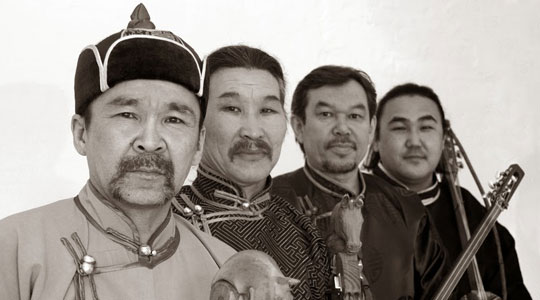Huun-Huur-Tu
[RU]

If you were to journey to the geographical center of Asia you would reach Tuva, an autonomous republic on the Russian-Mongolian border. This is the home of Huun-Huur-Tu, a group of fascinating overtone- and throat singers whose language can be traced from Turkish and whose culture reflects many similarities to that of Mongolia. Tuvan throat singers produce up to three notes simultaneously by selectively amplifying harmonics naturally present in their voices.
Sasha Bapa, his brother Sayan, and two other musicians, Kaigal-ool Khovalyg and Albert Kuvezin, formed Huun-Huur-Tu in 1992 to focus on the performance of, as Sasha put it, "old and forgotten songs". Sasha, Sayan, and Kaigal-ool were refugees from one of the large state-managed song and dance ensembles that became a fixture of official cultural life during the Soviet era. For decades these ensembles, with their glitzy performances of folk music or pseudo folk music, offered close to the only outlet for young musicians who wanted to earn a living playing indigenous music. But as the music business has become increasingly privatized throughout the former Soviet Union, many musicians abandoned the state ensembles and formed their own groups.
While Huun-Huur-Tu devote themselves to learning old songs and tunes, their performances reflect the values of innovation as much as tradition. For example, the very notion of an ensemble like Huun-Huur-Tu is new to Tuva: Most Tuvan music has traditionally been performed by a solo singer or instrumentalist, and musicians have tended to specialize in a particular genre or musical style. These genres and styles in turn have deep roots in particular kinds of social occasions. By contrast, Huun-Huur-Tu's eclectic concert presentations of old songs and tunes fall between the cracks of Tuvan musical life.
"In Tuva, there's still no real context for what we do," says Sasha Bapa. "We perform there only rarely because it's so difficult for an independent group like ours: where can we find a good hall and sound equipment, and transportation to get there? How can we deal with all the government and commercial structures that still control a lot of the booking? And who can offer fees that will support us even modestly as professional musicians? Kaigal-ool Khovalyg, the musical leader of our group, might be better known in America than in Tuva. We're trying to preserve our musical heritage, but at the same time, we're trying to look forward. If a musical tradition stops evolving, it is destined to die."
Traditionally attired, the quartet alternates between solo and ensemble works. For CTM Siberia the ensemble appears with current members: Kaigal-ool Khovalyg (voice, igil, doshpuluur, Chanzy), Anatoly Kuular (voice, byzaanchi, khomuz, amarga), Sayan Bapa (voice, doshpuluur, marinhuur, guitar) and Alexey Saryglar (voice, tungur (drum), dazhaaning khavy (rattle)).
Biography from WorldMusicCentral.org / Jaro Medien.

































